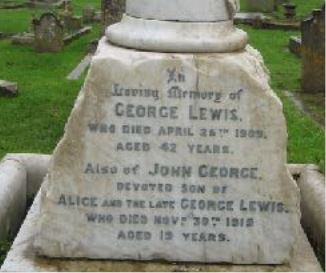2/4th Battalion, Duke of Edinburgh’s (Wiltshire Regiment)

John George Lewis was probably known as ‘Jack’ and that name appears in some of the records relating to him.
He was born on 19 September 1896 at Tetbury and baptised on 14 October of that year. His parents were George Lewis (1867-1909) and his wife Alice Davidson (1861-1938). George Lewis was a baker and confectioner. They are believed to have had three children besides John George: Alexander Hastings (born 1892): Mona Alice, (born 1894) and Francis (Frank) Charles (1899).
The 1901 Census shows the family living at the Chapel of Plymouth Bretheren in Tetbury. Jack was obviously sent off to boarding school, as he appears in the 1911 Census as a student at Queen’s College, Taunton (aged 14).
Jack had a relatively short but unusual time in military service, as a surviving Army Pension Record reveals.
His occupation prior to enlisting was a trainee auctioneer. He enlisted for service (as Jack George Lewis) in the Territorial Force, for four years or the duration of the war, at Trowbridge on 8 December 1914 and was posted to the 2/4th Battalion of the Wiltshire Regiment. His enlistment papers do not state his age, which was 18 but chances are he had overstated it by a year, as 19 was the minimum age for a posting abroad. He gave his address as Long Street, Tetbury. Within days of being enlisted (on 13 December) he was on ship, in company with his battalion, bound for India. He arrived in India on 8 January 1915 and the battalion was sent to Poona (now Pune) in Maharashtra. Whilst on the voyage out Jack had felt increasing ‘out of sorts’ and had been increasingly thirsty. On arrival in Poona he reported sick and was admitted to hospital on 11 January 1915, where he stayed for 24 days. It was discovered that he had diabetes mellitus and on 27 January 1915 he appeared before an Invalidity Board. The Board was of the opinion that he was physically unfit for military service and he was sent home, arriving at Netley Hospital, Southampton on 29 March 1915, where he spent 19 days as a patient. His condition was reviewed towards the end of April and as there was no sign of an improvement he was discharged from the Army, as no longer physically fit for war service and what was considered total incapacity. It was believed that his condition had arisen in October 1914, so prior to enlistment. In all he had served just 148 days in the Army and left with a ‘good character’ affirmation.
There was little that could be done to treat diabetes, other than dietary control, prior to the discovery of insulin in the 1920s, so it is perhaps not surprising that Jack died at home in Tetbury on 30 November 1915, aged 19.
He was buried in Tetbury (St Saviour’s Churchyard) in what appears to be a family plot, surmounted by a marble stone column. At its base are the names of Jack and both his parents, with their respective dates of death. The CWGC records indicate that A H Lewis of Long Street, Tetbury was the principal contact regarding the grave. Presumably this was Jack’s elder brother, Alexander Hastings.
Jack is commemorated on the Tetbury War Memorial.

Researched by Graham Adams 24 May 2021
